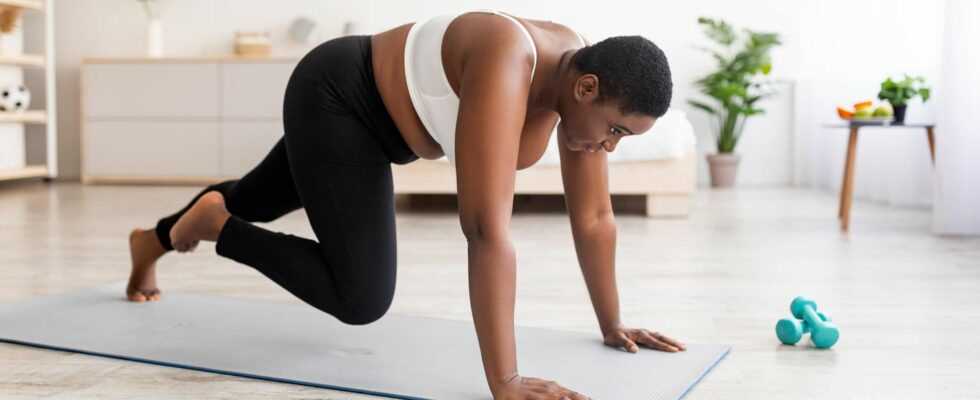Gentle and effective
7 quick exercises for more movement in the home office
Mountain climbers are considered a super effective exercise and can do without dumbbells
© Prostock-studio / Shutterstock
It doesn’t have to be a marathon: movement can also be built in between the desk, refrigerator and sofa – even with fun.
The neck hurts, the hips are kind of stiff: time to move! Unfortunately, this tends to get lost in the home office, our number of steps is lower than in the office and getting up for the gym is often difficult. No problem! We have an effective home workout that strengthens abs, legs and butt. Our suggestion: Hold static exercises for 20 seconds, repeat dynamic exercises 10 times per side – a total of three rounds. Increase from workout to workout.
Workout: Exercises for the home office
1.Russian twist
Russian twists are a hit, especially for the lateral abs.
- You sit on the floor, lean your upper body (careful, straight back!) backwards a bit – this automatically creates tension in your stomach. The legs can be placed on the ground with the heels (beginners) or held in the air (advanced).
- Then you turn your upper body to the side as far as possible – your gaze goes with you. A great exercise to work with weights later.
2. Mountain climbers
There is no getting around mountain climbers who want to effectively train their entire body. While the fast version is particularly useful as a cardio unit, slower versions are also effective, especially for the abdomen and core in general. The exercise uses many different muscle groups and trains stability.
- The starting position is the traditional push-up position.
- Now the knees are alternately led forward. You can do this straight, sideways or crossed – a combination is always good. This is how you train differently positioned abdominal muscles.
3. Plank
Abdominals, legs and buttocks training without planks, planks or whatever you want to call it is incomplete. The exercise is a super all-rounder, does not require any equipment and the success of regular training can be observed wonderfully. Because while 20 seconds of planks can be an enormous challenge for beginners, professionals take it to the extreme for minutes. Incidentally, the American George Hood is in the “Guinness Book of Records” – he remained in the forearm support for more than eight hours (!).
- Get into a lying position, supporting your forearms. The elbows must sit under the shoulders, the shoulder blades are pushed out so that a small hill forms. Now raise your body so that only your forearms and ten tips are touching the floor.
- The entire body, especially the stomach, legs and buttocks, becomes tense and just like a board. The bottom is not stretched in the air, but the body is not sagging either. Stomach and bottom are firm. When you are motionless, you “only” have to fight your own weaker bastard and hold your position.
4. Squat
If you want to get your legs in shape, you can’t avoid squats (knee bends). In order not to fall into routine and avoid boredom, squats can be performed in numerous variations. Whether standing with your feet hip-width apart or with your legs wide apart (so-called sumo squats) or in combination with a jump (so-called squat jumps) – the most important thing is: keep your back straight, push your butt out and make sure that your knees do not cross your toes protrude and do not “tilt” inwards.
- Stand on the flat floor with your feet hip-width apart.
- Now slowly squat down until your thighs are parallel to the floor, bringing your arms dynamically in front of your heart.
- Slowly come back to an upright position.
5. Boat
The yoga posture “The Boat” (“Navasana” in Sanskrit) is one of the most effective exercises for the core – it primarily strengthens the deep muscles in the stomach and back.
- First, come into a seated position with your legs straight and your back straight.
- Next, using the strength of your abdominal muscles, lift your legs and tilt your upper body back slightly so that you can hold a right angle in your hips. The arms are stretched out straight in front of the torso.
- Hold the boat for about 20 seconds. Make sure your back stays straight and you lift your breastbone up.
- If you want to make the exercise dynamic, you can also slowly lower your arms and legs to the floor and raise them again.
6. Donkey kick
This exercise with the somewhat strange name is also great for the buttocks and legs.
- Get on all fours. The hands should be straight under the shoulders.
- Now lift one leg bent backwards and move your foot towards the ceiling as if you want to step out upwards. Make sure your hips and back form a straight line.
- Lower the leg back down without touching the floor completely.
- Then step out again with your leg bent.
- Repeat the exercise on both sides.
7. Downward Dog with Elevation
The Downward Facing Dog is a classic yoga pose, slightly modified to give power to the muscles in your arms and legs.
- First, get into the actual Downward Facing Dog: Your arms are in front of your body and are stretched, while you support yourself with your hands on the floor.
- The legs are also stretched straight, which means that the entire weight of the body rests on the feet and hands and your body forms a kind of inverted V.
- Extend one leg back and up so it forms a straight line with your back and your hands.
- Then push yourself forward into the plank position and slowly pull the extended leg forward toward your chest at a 90-degree angle. If possible, bend your back so that you can touch your knee with the tip of your chin.
- Release the position by moving the leg back and lowering yourself back into Downward-Facing Dog.
- Repeat the exercise with the other side.

